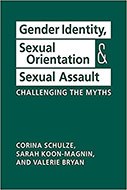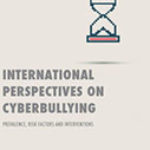Gender Identity, Sexual Orientation, And Sexual Assault: Challenging The Myths

Authors: Corina Schulze, Sarah Koon-Magnin, and Valerie Bryan
Publisher: Boulder, CO: Lynne Rienner Publishers, 2019. 235p.
Reviewer: Lauren Fifield Bellamy | July 2020
Through both quantitative and qualitative methods, Corina Schulze and her co-authors surveyed and interviewed members of the queer community to discuss sexual assault, disclosure, and how rape myths affect both the heterosexual and queer communities. Their book is segmented into seven chapters containing the following information: understanding sexual violence, the importance of identity, disclosure of assaults, rape myths and culture, and the Identity Inclusive Sexual Assault Myth Scale (IISAMS). These are followed by a discussion of areas of concern and recommendations, and a summary. The layout of each chapter is reader friendly, in that each begins with a quote from a research participant, a short introduction into the new material, and then a closing summary before the chapter’s notes section. For the reader, it is beneficial to have a distinct summary of each chapter, as well as those specific chapter notes, for ease of reference.
Chapter 1 directly situates the frame of reference for the book — the mistaken assumption that rape must involve a male participant. More specifically, the predominant myth of rape and sexual assault is that it involves a heterosexual male victimizing a heterosexual female. This myth thus excludes male victims or same-sex assaults. The authors explain that heteronormativity and oppositional sexism are two understudied aspects of the rape culture. They hope the text can bring social awareness to how identity and sexuality relate to sexual violence. In this first chapter, the authors also discuss the key features of the book and lay out explicitly the intended contributions of their work.
Chapter 2, The Importance of Identity, contains the most detailed data analysis. The authors explain their qualitative protocol– consensual qualitative research (CQR) — where three members of a five-member research team come to consensus about the way to categorize the data. The data collected from each phase of the research were then sent to an auditor to further ensure they were categorized accurately. For all readers, especially researchers in the field, this detailed explanation of CQR makes it clear and concise. But even a lay reader will be able to understand how the researchers analyzed their findings.
Continuing with the data analysis of chapter 2, the researchers explain how they obtained their 22-participant sample for the interview phase from a larger survey of mostly queer undergraduate students. Each interview was transcribed, and three members of the research team, per the CQR protocol, coded the transcription independently and identified core themes that were called domains. The domains covered in the book are as follows: participant identity, sexual assault knowledge, personal experiences, personal disclosure experiences, relevance of rape myths to the queer community, new rape myths in the queer community, unique concerns in the queer community about sexual assault, and lastly, prevention and response services. Overall, this chapter presents a wealth of information about identity and personal knowledge of sexual assault; however, it may be difficult for some readers to process the considerable amount of data and tables. Also, due to the dense findings discussed in the chapter, its summary would have been better served to summarize specific domain information and clearly state what the authors viewed as being the most important takeaway aspects.
Chapter 3 focuses on personal experiences with sexual assault and the extent, if any, of the disclosure of these experiences to others. The chapter’s introduction provides supportive statistics for the fact that sexual minorities have an increased risk of victimization when compared to heterosexuals. The relative brevity here leaves the reader wanting more details, explanation and depth. After reading such a lengthy discussion of findings immediately prior, this chapter seems to fall short in comparison. The notes do point out that the authors were selective in the material they chose to include to ensure the focus was just on disclosure, and not on the details of the sexual assault, and also to ensure the anonymity of the participants.
Rape myths, such as victim blaming, excusing the perpetrator, and discounting the seriousness of sexual assault are discussed in chapter 4. The researchers provided the 22 participants with the Illinois Rape Myth Acceptance Scale (IRMAS) to have as a guide during the interview. The focus of these conversations was to investigate the relevance of rape myths in the queer and heterosexual communities. Some of these myths include alcohol related myths that discount rape due to intoxication, unclear consent, false claims, and the queer community’s treatment of sexual assault. This chapter combines short quotes and paraphrasing in tables, as well as lengthy embedded quotes from the participants.
Chapter 5 explains the rationale for showing the participants the IRMAS prior to the interview. The chapter focuses on what members of the queer community feel has been left out of this survey instrument. Once the participants commented on what they felt was relevant from the survey and their community, they expanded on what specifically was needed in addition, to encompass more of the queer community. The categories for the domain of these new rape myths in the queer community include failure to recognize all forms of sexual assault, victim blaming, motivations for assault against the queer community, and perceptions of queer people impacting understanding.
The unique concerns and resources chapter describes several policy directions for sexual assault, as well as the specific concerns about sexual assault based on subgroupings within the queer community. A policy change is definitely needed to expand the definition of sexual assault. Sexual assault, the authors emphasize, can no longer be categorized solely by just a form of penetration or by the use of a penis.
This chapter ends by presenting strategies to reduce the current sexual assault rates in the queer community and to make all victims feel supported. For starters, the authors point out, people need to acknowledge that the perpetuation of rape myths is a problem that needs addressing. Education needs to be provided to the masses in order to dismantle these myths — in the form of public events, forums, and more inclusive sex education in public schools. Education is also needed on how to protect oneself in high-risk situations, as well as safely using social media and dating apps. There is also, they say, a need for training first responders on how to handle disclosures of sexual assault from members of the queer community.
In conclusion, Schulze, Koon-Magnin and Bryan present their findings from a 22-participant study. The reader will walk away with a wealth of knowledge about how sexual minorities are more likely to be victims of sexual assaults, as well as how gender identity and sexual orientation intersect with how one views, experiences, and discloses sexual assault. As one of the key features of the book, the authors hope the text will inform first responders and other policymakers. The book has strong information and recommendations to present, but there is the possibility that policymakers or first responders will not be able to get through the text and/or fully comprehend the message because of the density of the data analyses, findings, and tables. Also, if a continuous theme of the book is that the queer community isn’t understood because of a lack of knowledge and education, it would have been beneficial to include a small section or introductory paragraph explaining the subgroups within the LGBTQ community. While it is understood that each subgroup can be viewed as another label in society, for someone with minimal knowledge of the queer community, it would have been helpful to include some simple definitions or clarification of terms for the reader. For example, define transgender, transsexual, asexual, queer v. gay, etc. Lastly, the book discusses the intersection of gender identity and sexual orientation with regards to sexual assault, but does not include any consideration of race. The authors acknowledge this as resulting from the study participants being predominately white. Further studies are thus needed on how specifically people of color experience, disclose and heal from sexual assault.
Lauren Fifield Bellamy, Ph.D. Student, Darden College of Education – Curriculum and Instruction, Old Dominion University


